What Is Email Marketing? | Everything You Need to Know
If you click to purchase a product or service based on our independent recommendations and impartial reviews, we may receive a commission. Learn more
With modern-day digital marketing strategies aplenty, there are tons of ways to drive traffic and generate sales, from setting up a store using a website builder to partnering with influencers on social media. One method, in particular, remains just as important today as it was when it was created, way back in 1971: email marketing.
Skip to today, and this golden oldie is still a formidable vehicle for driving sales, building engagement, and nurturing customer relationships. In our opinion, it’s a marketing must, and – even better – you won’t have to pay a ton of money to reap its rewards. However, there’s many email marketing dos and don’ts, and if you want to get the most out of it, you’ll need to understand exactly how it works.
In this guide, we’ll help break down what email marketing is and how it works. We’ll also show you exactly why you should be using it, and how to get started with your very own email marketing strategy!
What Is Email Marketing?
Email marketing is a form of digital marketing that involves sending emails to a list of users that have consented to receiving correspondence from your business.
Often, these emails are promotional, but they can also be informational. From boosting conversions and driving traffic, to cultivating a large and loyal base of followers, the purpose can vary widely.
On the surface, email marketing might not sound like the most exciting of marketing channels, but things have come a long way from boring, text-dominant sends. Nowadays, email marketers are embracing high-impact designs, as well as making the most of personalization and segmentation.
Here are some terms that you need to know when it comes to email marketing:
- Subscribers – these are the people that sign up to receive emails from you.
- Email list – this is a list of all your subscribers.
- Email service providers (ESPs) – these are platforms that you can use to send your marketing emails. Some website platforms have built in email tools, or you may choose to use an external ESP such as Mailchimp.
- Opt-in and permission-based marketing – opting-in is when a subcribers gives you permission to send them emails, permission-based marketing is simply marketing to those who have given you permission to do so.
- Email campaigns – email campaigns is the term used to describe sending several related marketing emails to your email list or a segment of your list
- Automation – email automation is when your email campaigns are set up to send automatically based on a particular trigger (such as a new subscriber).
How Does Email Marketing Work?
So, now that we’ve covered what email marketing is, it’s time for us to dig into the technicalities of how this digital marketing staple actually works.
Email marketers use an Email Service Provider (ESP) to create and send emails to their subscriber lists. These ESPs are also known as email marketing platforms.

Now, you might be wondering why you can’t just use your personal email inbox when sending to your subscribers. It’s a good question that’s worth digging into a bit.
In the simplest terms, personal inboxes just aren’t built to support the level of sending that you’re likely to be doing when rolling out an email marketing strategy.
Firstly, you’ll struggle to create emails that have the slick and polished aesthetic you’d expect from a professional business. Unless you’re a coding maestro, creating anything beyond a wall of text will prove challenging. ESPs usually feature a drag-and-drop format that makes it simple to design something that both looks good, and accurately reflects your brand.
Secondly, if you send your emails from a regular inbox, they’re more likely to be labeled as spam. If you’re lucky, they might end up in the receiver’s junk folder, but it’s more likely they won’t even get that far. ESPs are usually approved by Internet Service Providers (Google, Yahoo, Hotmail and the like), so they’ll come with a ready-made positive reputation.
Lastly, ESPs usually have their own analytics features, which allow you to check the open rate, click-through rate, and general performance of your emails. They also let you segment your user lists based off of this data, so you can send more personalized emails.
Find Out More
Looking for an email service provider? Don’t sweat it! We’ve done the hard work for you and compiled our 6 Best Email Marketing Services, so you can find the one that’s right for you.
Types of Emails
Modern email marketing doesn’t adopt a ‘one-size-fits all’ approach. On the contrary, there are a number of different types of emails that you can send as part of your email marketing strategy, each of which fulfils a different purpose.
Below, we’ve provided some examples of different emails you can send, as well as what they’re best for.
Promotional Emails
The most common use of email marketing is to send promotional emails. These usually contain a special offer or a call-to-action (CTA), and their purpose is to increase sales.

Promotional emails are often brightly colored, and draw attention to the discount or deal on offer. The layout of the email will lead the reader down to that all-important CTA, so they have a clear idea of what action to take next.
These emails can be sent on their own, or as part of a campaign. Usually, marketers will schedule in at least a few reminder emails after the main send, so that the promotion remains fresh in their subscribers’ minds.
Informational Emails
Email marketing isn’t just about drawing attention to the newest discounts – it’s also about promoting your brand. This is where informational emails come in.
Newsletters and announcement emails fall under this umbrella, as their sole purpose is to raise brand awareness and keep engagement levels up.

Often, informational emails will contain links to your latest website posts, so they’re a great way to increase traffic to your site, and therefore give your business more exposure. In fact, according to the Content Marketing Institute, 31% of B2B marketers cite email newsletters as the most effective way to nurture leads.
Transactional Emails
Both promotional and informational emails are considered to be ‘commercial’ sends, however, there’s another type of email that tends to sit outside of this bracket. These are called transactional emails, and they serve a different purpose to their commercial counterparts.
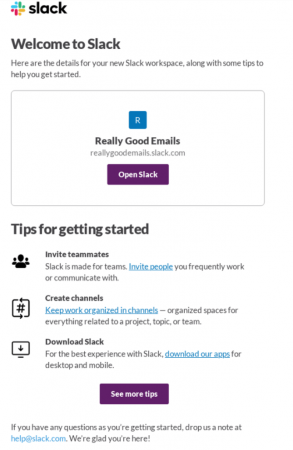
Whereas a commercial email is sent to try to make a sale or build engagement, transactional emails are sent in response to a user action – such as making a purchase or signing up for something. These emails don’t typically contain any commercial features, such as a CTA or special offer.
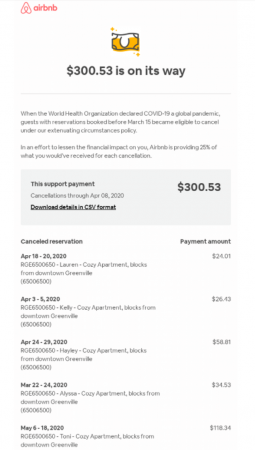
More Information
- Monthly Newsletter Examples: Check out these newsletters for inspiration
The Benefits of Email Marketing
Given that email is fast approaching its 51st birthday, you’d be forgiven for thinking that it might be redundant in the current fast-paced world of digital marketing. However, it’s more relevant than ever – and boasts a long list of benefits.
Drives Traffic and Boosts Conversions
99% of email users check their inbox every day – and if that kind of eager anticipation doesn’t signal a receptive audience, we don’t know what does! If you can get even a fraction of those on your list to open and click your emails, you’re well on your way to driving traffic to your website, and boosting your conversions.
Using a good mix of promotional and informational emails will help encourage your subscribers to use your emails as a springboard to your website. And the more visitors you get, the more likely you are to make a sale!
Small businesses found it difficult to boost their sales last year and this year. However, email marketing is one of the most effective strategies to increase sales, especially if traffic to your store is down significantly.
If they receive a timely offer, some clients will make a purchase decision. Adding urgency to your offers and providing big discounts or free shipping are great strategies to turn a subscriber into a buyer.
Additionally, email marketing can be an effective strategy to upsell existing clients. Customers who haven’t purchased in a while can be re-engaged. You can encourage your audience to buy from your company by creating personalized and targeted offers for customers on your email list.

Sep Niakan is the Founder of www.condoblackbook.com and the Managing Broker and Owner of BlackBook Properties.
It’s Affordable
Out of all the marketing channels you can pick from, email marketing delivers the best return on investment (ROI), averaging a return of $42 for every $1 spent. That’s equivalent to a whopping 4200%!
Even better, getting started with an email marketing platform doesn’t have to cost the Earth. In fact, sometimes it doesn’t have to cost anything. If you know how, you can get a Mailchimp and Sendinblue both offer free plans, so you can test their services before committing to a paid package.
Learn more about email marketing ROI in our full statistics report!
It’s Scalable
The good news is that email marketing isn’t all or nothing. Most email marketing providers offer a tiered pricing structure, so you can choose the band that is most relevant to your business. As your brand – and your email list – grows, you can upgrade as necessary.
A good email marketing provider should also offer a basic level of automation (at the least), so as your reach increases, you can use workflows to manage your emails. This means you won’t have to physically hit the send button for each one, making it much more efficient.
Offers Personalization and Segmentation
Nowadays, personalization isn’t something that consumers like to see: it’s something that they expect to see. And we’re not just talking about including their first name in your copy – although that’s a good start!
Using email marketing allows you to take personalization to the next level. Analytics provide a window into your users’ behaviors, so you can see what they like and what they don’t, giving you the knowledge to segment them and send them more of what they want.
The results speak for themselves: marketers who use segmented campaigns have seen up to a 760% increase in revenue. This is down to the fact that a personalized email experience is more persuasive than a cookie-cutter template that has little or no relevance to certain groups of your subscribers.
Most marketers would gladly pay to ensure that their money was only going to people who were interested in their brand. However, email marketers can take it a step further by sending emails just to subscribers who fulfill particular criteria.
If a franchise only has an offer available in particular parts of the country, it is simple to arrange for emails to be sent just to people who live in those areas. If there is a sale on sporting products, only those who have expressed an interest in sports will receive an email.
Brands that want to learn more about their subscribers must use email list segmentation to their advantage. Being a digital marketing professional, I strongly believe marketers who employ this strategy have higher engagement rates as a result.
The old ‘spray and pray’ strategy of sending the same email to every subscriber or customer is no longer effective, and the organizations that get the best results from email marketing segment their data and campaigns to guarantee that they’re sending the most appropriate message to each individual.

Exploding Topics uncovers trends before they take off. Thousands of companies (including Shopify, Google, Apple, and Netflix) use Exploding Topics’ data to inform decisions on products, investments, and more.
Gives You Full Control
Social media is the darling of the 21st century, but its fickle nature makes it a particularly tricky channel to master. Because its feeds are managed by algorithms, there’s no guarantee that your post will be seen by your target audience.
Email is much more straightforward. Assuming that your email sends have a good reputation, most of them will make it into your recipients’ inboxes. Plus, their higher levels of personalization mean you’re more likely to receive a positive response from your audience.
It’s no surprise that 4 out of 5 marketers said they’d rather give up social media than email marketing – the latter gives you more control over your campaigns!
Email marketing makes so much sense for businesses because, aside from SEO, it offers unparalleled control. You are the owner of your company’s email list because it is something you have built out organically. Social media marketing and paid ads, on the other hand, depend on algorithms to give you exposure, which is not under your control. The reach, control and personalization of email marketing are what continue to make this channel so important and widely used.

Build Relationships
Once a customer clicks away from your website, it won’t be long before your business leaves their mind forever. You need to work that little bit harder to carve out a foothold, so that they’ll come back to you when they need you.
Email marketing is a great way to stay present in customers’ thoughts – a regular email in the inbox will stop them from forgetting about you. Bit by bit, you’ll be able to build a relationship with them so that they become your first choice.
Before you know it, you’ll have a whole community of customers, who look forward to reading your emails!
Plenty of Room to Get it Right
You’re never going to get everything right on the first try, which is why A/B testing is so useful. This is when two different versions of an email are sent to your email list, with half of your subscribers receiving the ‘A’ email, and the other half receiving the ‘B’ version. You can then see which email variation performs better.
This is a great way to get your emails into a cycle of constant improvement, based on data from interactions with real-life subscribers. Rather than just crossing your fingers and hoping for the best, A/B testing allows you to check that your emails are the best they can be, and it allows you to try out some of those wackier ideas without so much risk attached! Even if people leave, it’s not the end, as Win Back Emails are a cornerstone for reclaiming those lost subscribers.
Paul Sherman, the Chief Marketing Officer at Olive, recommends using testing not only to nail your strategy, but to get to know your customer base better, too:
“Owing to the nature of email marketing, feedback is near immediate, and can be readily put into practice for further testing and tweaking. Perhaps you’re making small changes to your email’s subject line and want to see the change it makes to your open rate. Or, you might choose to experiment with two slightly different calls to action (CTAs) to see which one results in a higher conversion rate.
The great thing about email marketing is that it’s multifaceted – not only are you communicating directly with your target audience, but you’re learning more about that audience by doing so. You can retain what works well, and discard what doesn’t.”
Are There Any Downsides to Email Marketing?
Deliverability
In an ideal world, every email you send would end up in your subscribers’ inboxes. Unfortunately, that’s not how it works, and deliverability can turn out to be your worst enemy.
Deliverability is what marketers use to measure how likely their emails are to reach the inbox, and it can be affected by a whole host of factors. Mostly, it boils down to whether or not an Internet Service Provider (Gmail, Yahoo, Hotmail) thinks your emails are spam.
If this decision goes against you, all of your carefully designed sends will end up in the junk folder, and no one will read your perfectly curated subject lines.
For more advice around how to improve email deliverability, check out our dedicated guide to just that. And trust us – it delivers!
Multi-Device Optimization
This isn’t a downside per se, but it is something you need to think about. Over half of internet traffic comes from mobile devices, which means your emails need to be optimized for phones and tablets.
Sometimes, this means you might need to rethink your layout, or the size of the images that you include. You’re likely to lose subscribers much faster if your design is only suitable for desktop, but is horribly distorted when opened on a mobile device.
Time-Intensive
Although automation can take some stress out of coming up with an email marketing strategy, you’re still going to have to devote quite a lot of time to creating the emails in the first place. Automation only takes care of the sending part – the email creation is all up to you.
If you’re a one-person startup, or your team is quite small, finding the resource to dedicate to this task can be quite tricky. The good news, however, is that you only have to do it once, so after the initial setup, you just have to focus on keeping it all up-to-date.
The best thing about email marketing, for us, is the personalization we can create, both based on personal data we have for each recipient but also based on the behaviors they take – on our website, with our staff, and elsewhere. This allows our email marketing to bring them the right message at just the right time (not to mention the efficiencies gained through automating these processes).
That said, there are certainly challenges to email marketing. Inboxes have never been more full of messages, and so our messages can certainly get lost in the mix if we’re not strategic with our timing, subject lines, and frequency. And, of course, we need to always provide value for our subscribers. This means constant creativity to produce content that really helps people as they consider partnering with us on their own brand strategy.
At the end of the day, email marketing is crucial to our success. We’ve been able to grow our business significantly in the past 4 years (when we got really serious about email marketing). And we’ve been seeing a definite positive response from those who engage with our content. I regularly get kudos from subscribers to our email newsletter for its depth and value of content.

Mike is the CEO and Managing Partner of branding agency Resound (www.resoundcreative.com). He's also written a book - You are Remarkable: Unlock your authentic brand to win loyal customers - and co-hosts the podcast AZ Brandcast.
How to Start Email Marketing
Now that you know what email marketing is, how it works, and what benefits it can bring to your business, it’s time to explore the good stuff: how exactly do you start email marketing? It’s actually much simpler than you might think, but still requires a bit of planning.
1. Choose an Email Service Provider
Before you can start email marketing, you need to pick an email service provider (ESP) to manage your emails and your subscribers. To help you make your choice, and narrow down your options, here are a few questions to ask yourself:
- What’s your budget? ESPs have a range of different plans on offer. However, they usually have a standard plan with the cheapest monthly cost.
- How many subscribers are you planning to have on your list? Typically, ESPs organize their plans by contact list size – so if you know you’re going to have a larger list, you’ll need to opt for a more advanced plan.
- Do you know how many emails you’re going to send? Different plans often offer different sending volumes, so make sure you pick one that has enough capacity for your purposes.
- Do you need automation? If you’re keen to automate your email sends, check that your chosen ESP supports email workflows – not all of them do!
- How much tech know-how do you have? If you’re a relative newbie, look for an ESP with a drag-and-drop builder. These make it easier to design good-looking emails without needing to use code.
Unfortunately, we can’t tell you which one to pick – that all depends on your needs – but we can make some suggestions!
Our top three email providers are GetResponse, ActiveCampaign, and Mailchimp. All three are super easy to use, but we recommend ActiveCampaign for dedicated marketing professionals. If you’re just starting out, both GetResponse and Mailchimp are great choices, but Mailchimp is particularly good if you run an ecommerce business, thanks to its integration with platforms like BigCommerce.
Further reading:
6 Best Email Marketing Providers
Best Email Marketing WordPress Plugins
2. Build Your Email List
Once you’ve chosen your ESP, the next step is to build your subscriber list. The best way to do this is by making sure your website contains at least one email capture box. This can either be in the form of a pop-up, or can be built into the design of your page, just so long as your users can enter their email address and sign up.
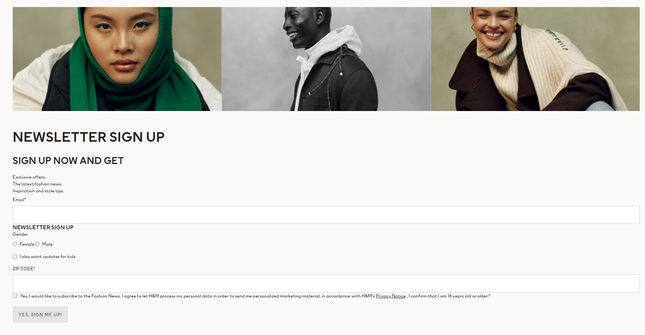
When you create your signup box, make sure that you provide some way for users to give consent to receive your emails. It might sound silly (surely putting their email address in is consent enough?) but it’s important that you capture their explicit consent for you to hold their personal data, so that you can be sure you’re not accidentally breaching data protection guidelines. This is especially important if you’re planning to send emails to Europe, because of GDPR legislation.
If you want an example of what this looks like, take a look at the H&M capture form above. You’ll see a little tick box just before the final sign-up button.
It can be hard work building an email list, but it’s worth it in the long run – after all, you’ll end up with a dedicated list of subscribers who are genuinely interested in what you’re sending. As a result, your engagement metrics are likely to be much higher.
However, you might see certain services that offer to sell you a subscriber list. Although this is a quick way of sourcing a complete set of email addresses, we recommend that you don’t do this under any circumstances. Although it’s not illegal, it’s a highly questionable practice that can affect your email deliverability and overall reputation.
Plus, because none of those people have specifically opted in to receive emails from you, they aren’t going to care about what you’re sending. Your engagement metrics will plummet, and your email marketing strategy won’t have the effect you were hoping for.
3. Create Your Content
The last step in the process is to start creating your email content! Each ESP is slightly different, but they should all come with an editor that allows you to build your emails, whether through HTML or drag-and-drop.
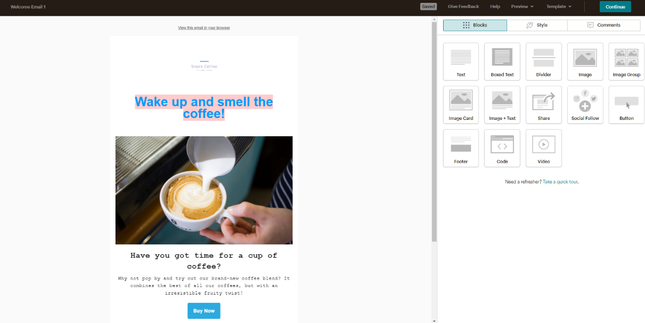
We recommend creating a welcome email to begin with. This is the first email your subscribers will see when they sign up to your list, so it’s worth spending some time on. Make sure you remind them who you are, and let them know what they can expect from your emails.
If you’re not sure what you want your emails to look like, turn to your own inbox for inspiration! It should be full of brands and companies that you admire, and there are bound to be a few ideas that you can test on your own sends!
Users like a consistent experience when interacting with a company, so make sure that you choose a design, font, and color scheme that matches your website branding. Not only will this look nicer, but it’ll also help to build a positive connection between your subscribers and your business.
Further Reading:
- Email Marketing Best Practices – check out our 11 email marketing best practices for top tips on how to make your strategy the best it can be!
- How To Write A Headline – get your emails opened and read!
- Marketing for Doctors – expert tips to help you create tailored marketing
Best Practices for Email Marketing
Want to get the most out of your email marketing? Follow these email marketing best practices:
Build a Strong Sender Reputation
Ask yourself – which marketing emails do you open?
Most of us only open and read emails from the people and businesses we know and trust. This is why building your sender reputation is so important.
Primarily, this can be done through ensuring that you only send high-quality, relevant, and engaging content to your email list.
However, you can also ensure a good reputation by practicing good email list “hygiene” such as managing bounce rates and ensuring unsubscribes are swiftly removed. Practicing good list hygiene can also help you avoid spam filters and blacklisting.
Design Mobile-Friendly Emails
Many people now check their emails on the go via their cellphone. So, if your emails look bad or don’t work on mobile, you are missing a huge opportunity to engage you’re your audience.
Ensure that your emails are responsive to all platforms. Luckily, many email providers will automatically make your emails mobile-friendly. However, you should test your emails on several platforms to make sure they look and work well.
When creating emails, you can improve their readability on mobile by using short subject lines, carefully considering where you use images, and keeping your copy short and concise.
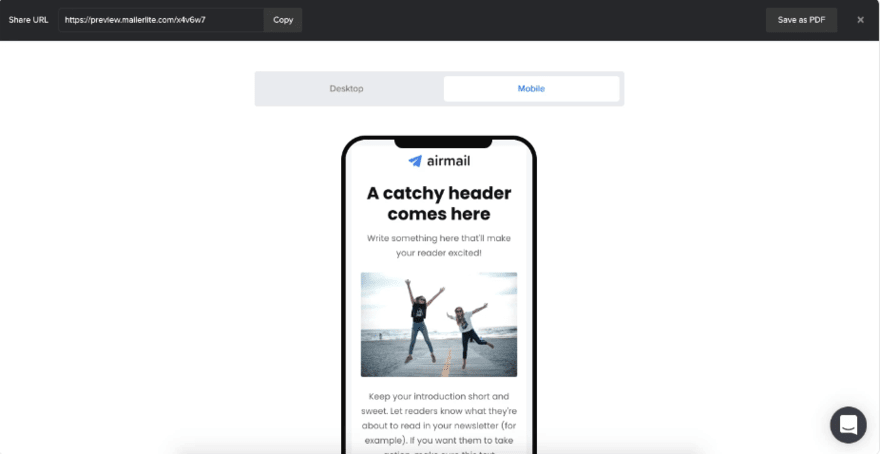
Test and Optimize Your Email Campaigns
Although there are lots of best practices you can abide by, ultimately what works best for your business will depend on countless factors. The best way to find your unique “magic formula” is to test your emails.
A good approach to this is to use A/B testing. This is where you send almost identical emails to two similar lists, changing only once factor (such as subject line, layout or content) and seeing which ones perform best.
You can use the details analytics that many email marketing providers offer in order to asses email success and help you identify areas for optimization.
Find Out More
- Discover the top Email Marketing Strategy Examples for more insights into how you can put these best practices into action.
Email Marketing Trends and Innovations
Keeping on top of email marketing trends and innovations can help you remain relevant and ahead of your competition. Here are some key trends and innovations that are worth noting:
Personalization and Dynamic Content
Personalization and dynamic content are a crucial part of email marketing, helping you to create highly targeted and engaging emails.
It simply involves tailoring your email content to the recipient. On a basic level this could include using the recipient’s name in the email, but could also include tailoring product recommendations based on the information provided by the recipient or based on their order history.
Interactive and Engaging Emails
Sending interactive emails can drastically increase engagement. Doing so will start a chain of positive action, which can ultimately end in a sale or other valuable interaction with your brand.
Many email marketing providers and website platforms now allow you to easily add interactive elements to your marketing emails. This can include surveys, videos, image sliders, quizzes, and forms – which can all be used directly within the email.
Using these types of interactive element can also reduce friction, such as allowing recipients to fill out enquiry forms from in the email, rather than having to navigate to another part of the internet.
Integration with Other Marketing Channels
Great marketing is all about developing a strong message across various channels and touch points.
Integrating your email marketing with other channels is a smart way to do this. For example, you may integrate your emails with social media by including share buttons directly within them. Alternatively, you may sync customer interactions with your emails to your CRM to help deliver a more personalized experience for that customer in the future.
Artificial Intelligence (AI) and Machine Learning in Email Marketing
AI and machine learning are already playing an important role in better email marketing and will likely continue to do so.
For example, these tools can be used to supercharge personalization of marketing emails, to optimize content, help predict customer behaviour and trends, improve email deliverability, and enhance list segmentation to drive better results.
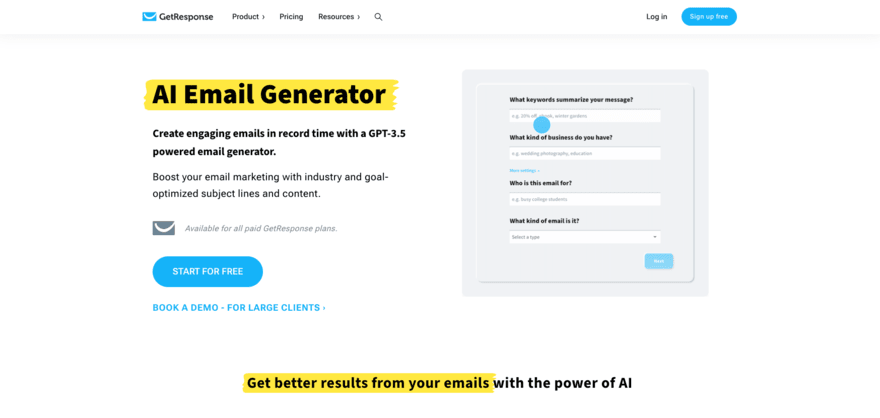
Email Marketing Metrics and Analytics
We have already mentioned how many email marketing platforms will offer you detailed analytics on your email performance. But unless you know what those metrics mean and which are the most important, they offer little benefit.
When you set up your email marketing campaigns, you should choose some Key Performance Indicators (KPIs). These are markers against metrics that you believe demonstrate a step towards email marketing success. Some metrics you could set KPIs against include:
- List size
- Open rate
- Click through rate
- Conversion rate
- Bounce rate
- Unsubscribe rate
- Share rate
The metrics you choose for your KPIs will have a big impact on how your emails perform. This is because you tend to focus most on improving the metrics which you measure. So, although your KPIs should be your most important metrics, monitoring other metrics can also ensure that you aren’t making any major mistakes.
For example, you may set a KPI for open rates, but fail to monitor list unsubscribes. Although your open rate may improve over time, if that is paired with a huge percentage of people unsubscribing from your list – this could have a net-negative impact on your performance.
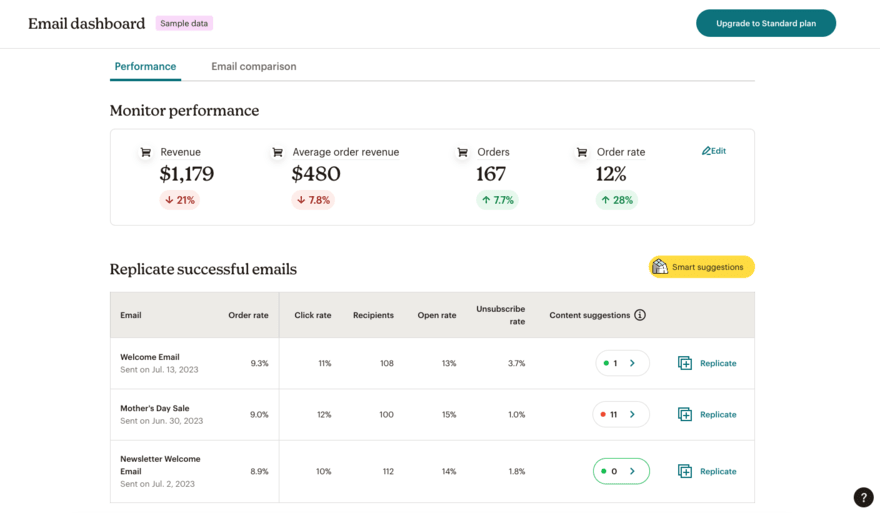
What Is Email Marketing: Summary
And that’s it! Email marketing is one of the oldest tricks in the book, but its age doesn’t mean you should ignore it in favor of more modern methods. In fact, we think this veteran has more than earned its place in the digital marketing hall of fame, and after reading this article, we bet you agree!
We can’t wait for you to dive into the world of email marketing, and build your own successful sending strategy. Make sure to come back and tell us all about your experiences in the comments section below – we want to hear how you get on!
FAQs
Make sure you also keep an eye on your own inbox. The industry is constantly changing, and the first sign of a new trend can often be found in the emails you receive from your favorite brands. If you see something you like, why not test it on your own emails?
Ultimately, though, you don’t need to choose between them. The best marketing strategy is often omni-channel, which means that you can use both social media marketing and email marketing if you want to!
We recommend sending between two and three emails a month to begin with. Once you’re comfortable with that, you can increase your sends to once, or even twice, weekly.
Building your own list might take longer, but the results, in the long run, will make it worth your while. Plus, subscribers that you collect yourself will be less inclined to complain about your emails – or mark them as spam – which will help improve your deliverability.
2 comments